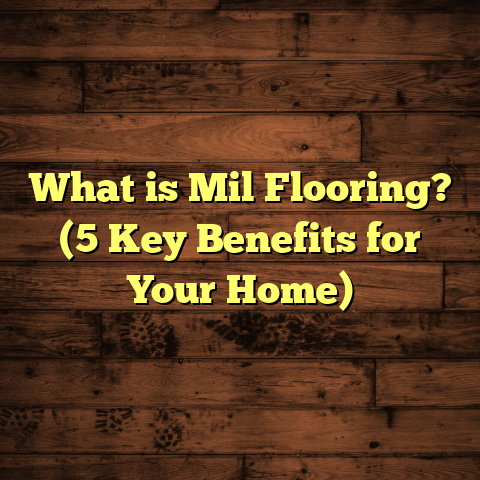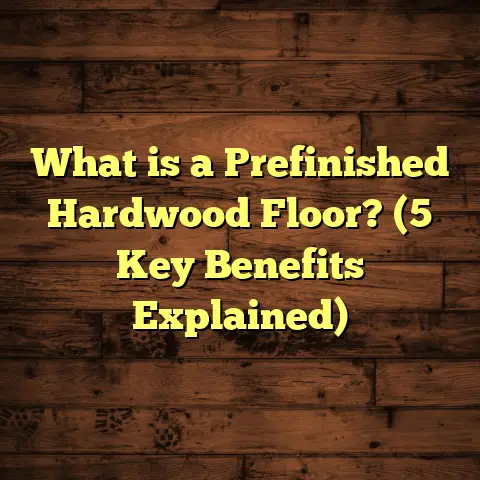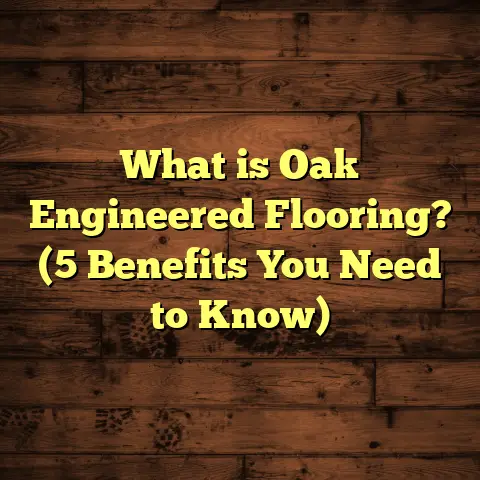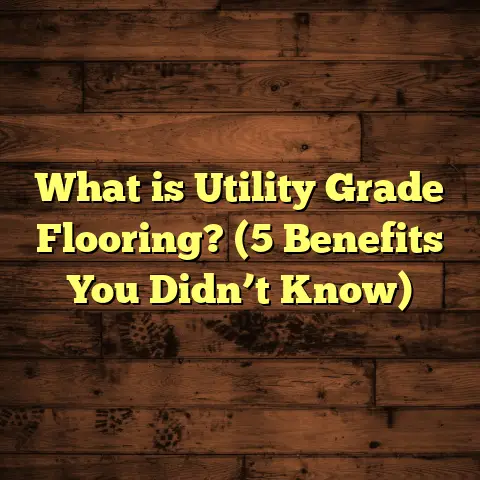What is a Ballroom Floor Made Of? (5 Key Materials Revealed)
What is a Ballroom Floor Made Of? (5 Key Materials Revealed)
When I think about value for money in flooring, especially ballroom floors,
I always focus on materials that offer durability, beauty, and performance
without breaking the bank. Having installed and studied various types of
ballroom floors over the years, I want to share what these floors are made of
and why certain materials stand out. If you’ve ever wondered what makes a
ballroom floor special and what materials best suit it, this chat is for you.
What Is a Ballroom Floor?
Simply put, a ballroom floor is the surface designed to support dancing and
events where people gather. But it’s not just any floor — it has to be smooth
enough for dancers to glide, tough enough to handle heavy foot traffic, and
often beautiful enough to match elegant surroundings.
Ballroom floors can vary widely depending on where they are — whether in grand
hotels, community centers, or private homes — but they mostly focus on a few
key materials known for their unique properties. So, what exactly goes into
making these floors?
If you’re like me and have seen a number of ballrooms over the years—from
wedding venues to dance academies—you’ll notice the floor is often the
unsung hero of the space. It’s got to hold up under intense use yet still feel
right underfoot. That’s why choosing the right material is crucial.
Let me walk you through the five key materials I’ve worked with and why each
one matters.
1. Hardwood: The Classic Choice
You’ve probably guessed this one first. Hardwood is the classic ballroom
flooring material, and for good reasons.
Why Hardwood?
- Durability and Resilience: Hardwood floors like maple or oak stand up well
to constant foot traffic and the impact of dance movements. - Smooth Finish: They provide a slick but not slippery surface that dancers love.
- Aesthetic Appeal: The natural grains and warm colors add elegance to any
ballroom setting. - Refinishing Potential: You can sand and refinish hardwood floors multiple
times to restore their beauty. - Longevity: Properly installed hardwood can last decades or even over a
century.
My Experience with Hardwood Floors
I remember installing a maple hardwood floor in an upscale dance studio a few
years ago. The client insisted on something that would last decades and still
look amazing. Maple’s tight grain and hardness rating of about 1450 on the Janka
scale made it perfect. It’s harder than oak (which scores around 1290), so it
resists dents better.
The installation process was labor-intensive—we used tongue-and-groove planks
that we nailed down over a plywood subfloor. After installation, we finished it
with a commercial-grade polyurethane finish that balanced gloss with grip.
Over time, the floor developed a beautiful patina but stayed structurally sound.
One thing I learned: maintenance matters. Regular sanding and refinishing every
7-10 years keep hardwood looking fresh.
A few things I noticed during use:
- Dance Comfort: Dancers commented that the floor felt “alive” underfoot — it
had just enough give to be comfortable but not too much bounce. - Noise Control: Hardwood floors can be noisy without underlayment or rugs, so
we added sound insulation beneath in some installations. - Wear Patterns: High-traffic areas required more frequent refinishing since
the finish wore off faster.
Data Point
According to the National Wood Flooring Association, hardwood floors can last
over 100 years with proper care, making them a great long-term investment.
Technical Details
- Hardwood species commonly used: maple, oak, cherry, ash.
- Thickness: Typically 3/4 inch (19mm) solid planks.
- Installation method: Nail-down or glue-down.
- Finish types: Oil-based or water-based polyurethane, aluminum oxide coatings.
In one project, we installed a 2,500 sq.ft maple hardwood ballroom floor costing
about $12 per square foot installed. That included materials, labor, sanding, and
finish. The client considered it high-end but appreciated the longevity and look.
2. Engineered Wood: Hardwood’s Modern Cousin
Engineered wood floors are a layered product with a hardwood veneer on top and
plywood or high-density fiberboard underneath.
Why Choose Engineered Wood?
- Stability: It handles humidity changes better than solid hardwood.
- Cost-Effective: Usually less expensive than solid hardwood but still offers
that wood look. - Easier Installation: Can be floated over many subfloors or glued down.
- Environmentally Friendly Options: Uses less hardwood per plank.
- Variety: Veneer thickness varies; thicker veneers allow more refinishing cycles.
My Take on Engineered Wood
I’ve worked on ballrooms where engineered wood was the perfect choice because
the building had moisture issues or the floor needed quick installation. I recall
a community center ballroom project where we used engineered oak. The clients
wanted that classic look but with better resistance to seasonal expansion and
contraction.
Engineered wood didn’t disappoint — it maintained its integrity through winter and
summer shifts without noticeable gaps.
Some things I noticed during installation:
- The floating installation cut down labor time by nearly 30%.
- The floor felt slightly less “solid” than traditional hardwood but was still firm.
- We used a click-lock system that made it easy to replace damaged planks later.
Cost Insight
Engineered wood flooring costs between $4 to $10 per square foot installed, while solid hardwood can run $8 to $15 per square foot or more, depending on species and finish.
Technical Details
- Typical veneer thickness: 2mm to 6mm.
- Core layers: Plywood, HDF (high-density fiberboard), or softwood.
- Installation types: Floating, glue-down, nail-down (less common).
- Surface finishes: Aluminum oxide for durability or UV-cured finishes.
Case Study
At a dance academy renovation I managed recently, we chose engineered wood for the main ballroom because:
- The building was older with some humidity fluctuation.
- Budget constraints limited use of solid hardwood.
- Installation had to be fast as classes resumed soon.
The flooring lasted over 5 years with no warping or cupping. Refinishing was possible once after heavy use.
3. Vinyl Dance Floors: The Practical Alternative
Vinyl has come a long way from cheap linoleum. Today’s luxury vinyl tiles (LVT) and sheets can mimic wood or stone but offer specific benefits for dance floors.
Why Vinyl?
- Shock Absorption: Provides some cushioning which reduces joint stress for dancers.
- Water Resistance: Ideal for venues with variable moisture conditions.
- Low Maintenance: Easy to clean and resistant to scratches.
- Cost-Efficient: Lower upfront cost helps budgets.
- Portability: Roll-out vinyl dance floors can be temporary for multi-use spaces.
My Vinyl Floor Stories
I installed a vinyl roll-out dance floor in a multi-purpose ballroom hall that hosts everything from weddings to fitness classes. The ease of installation allowed quick setup and takedown for different events.
While vinyl doesn’t have the same prestige as hardwood, it’s surprisingly durable. After three years of heavy use, the floor still looked great — no warping or cracking, just some minor scuffs that cleaned right off.
What surprised me most was how comfy the vinyl felt compared to harder surfaces. Dancers appreciated the slight cushion underfoot during long rehearsals.
Statistical Point
Vinyl flooring can last 10–20 years with proper care, making it a great budget-friendly choice for busy venues.
Technical Details
- Thickness ranges from 2mm up to 5mm or more for dance-specific vinyl.
- Surface textures vary from smooth to embossed wood grain patterns.
- Installation methods include glue-down or loose lay.
Cost Analysis
Vinyl dance floors generally cost between $2–$6 per square foot installed depending on quality and installation complexity. Temporary vinyl roll-out floors can be rented as well for events needing short-term flooring solutions.
Popular Brands & Products
Some vinyl products are specially designed for dance such as Harlequin Vinyl or Tarkett Sports vinyl floors. These offer enhanced durability and slip resistance.
4. Parquet Flooring: Patterned Wood Elegance
Parquet floors are made from small blocks of wood arranged in geometric patterns, often herringbone or basket weave.
Why Parquet?
- Visual Appeal: Offers intricate designs that add flair to ballrooms.
- Durability: Uses hardwood blocks similar to traditional floorboards.
- Customizable: Can mix wood species or finishes for unique looks.
- Historic Charm: Often found in heritage sites and classic ballrooms.
Personal Experience with Parquet
One standout project was restoring an old ballroom with original parquet flooring in a historic mansion. The geometric patterns brought old-world charm alive. It took patience to repair damaged blocks and refinish them properly, but the result was stunning.
Installing new parquet takes patience because each block must be laid carefully according to pattern rules — not just tossed down like regular planks. It’s labor-intensive but worth it if you want your ballroom floor to be a centerpiece visually.
Maintenance Notes
Parquet requires slightly higher maintenance than plain hardwood floors because:
- Individual blocks may loosen over time.
- Edges between blocks collect dirt more easily.
- Refinishing must be done carefully due to pattern complexity.
Cost Factor
Parquet flooring installation tends to be pricier, around $10–$20 per square foot due to labor-intensive pattern laying.
5. Sprung Floors: The Dance-Friendly Foundation
Not a material per se but often integrated under hardwood or vinyl is a sprung floor system designed to absorb shock.
What Is a Sprung Floor?
It’s a subfloor structure built with cushioning layers (foam, rubber pads, or wood blocks) to provide bounce and reduce injury risk during dancing.
Sprung floors reduce fatigue by absorbing impact forces from jumps and fast footwork — something very important for serious dancers.
Why I Recommend Sprung Floors
Whenever I install ballroom floors intended for serious dancing — ballet, ballroom competitions, or contemporary dance — I insist on a sprung subfloor. It protects dancers’ joints and improves performance comfort.
In one project for a dance academy, adding a sprung floor beneath engineered hardwood made all the difference in feedback from instructors and students alike. They noted less fatigue after long rehearsals.
Types of Sprung Floors
There are several designs:
- Foam-based: Affordable but less durable long term.
- Wood-block systems: Traditional method using small wooden blocks as springs.
- Rubber Pad systems: Modern approach with rubber pads or mats.
- Spring-loaded platforms: Expensive but offer maximum shock absorption.
Installation Complexity & Costs
Sprung floors add $4–$8 per square foot depending on materials but are invaluable for injury prevention and dance experience quality.
Installation requires precise leveling and moisture barriers to prevent damage underneath.
Comparing These Options Side-by-Side
So how do you pick? Here’s my take after handling multiple projects:
| Material | Durability | Cost (per sq.ft) | Maintenance | Best For |
|---|---|---|---|---|
| Hardwood | Very High | $8–$15 | Medium (refinishing) | Elegant ballrooms, longevity |
| Engineered Wood | High | $4–$10 | Low-Medium | Moisture-prone areas |
| Vinyl | Medium | $2–$6 | Low | Multi-use halls, budget projects |
| Parquet | High | $10–$20 | High | Decorative historic settings |
| Sprung Floor | N/A | $4–$8 (subfloor) | Low | Serious dance venues |
If you want value for money with longevity combined with dancer comfort, hardwood paired with a sprung floor is my go-to combo. But if budgets are tight or moisture is an issue, engineered wood or vinyl work well too.
Installation Tips I’ve Learned Over Time
Choosing the material is just half the battle—installation quality makes or breaks your ballroom floor’s performance.
Here are some tips I always keep in mind:
Subfloor Preparation
Never underestimate how important subfloor prep is:
- Ensure it’s flat within 3/16 inch over 10 feet.
- Moisture barriers are crucial especially for wood floors on concrete slabs.
- Clean thoroughly before installation—dust or debris will cause unevenness.
Acclimation of Wood
Hardwood or engineered wood planks should acclimate at least 3 days in the room where they will be installed. This prevents expansion/contraction issues later on.
In one job where the client skipped this step, we had noticeable gaps develop within months.
Expansion Gaps
Always leave an expansion gap around perimeter walls (~1/2 inch) so wood can expand without buckling under humidity changes.
This gap is usually hidden by baseboards or shoe molding afterward.
Finishing
The choice of finish affects durability:
- Oil-based polyurethane offers longer wear but longer dry time.
- Water-based dries quickly with less odor but may require more coats.
- Aluminum oxide coatings (factory applied) provide top durability—common in engineered wood planks.
How I Estimate Costs With FloorTally
Estimating flooring costs can get tricky with so many variables — materials, labor rates, waste factors, finishes. Over time, I’ve found tools like FloorTally really help me save time while planning projects accurately.
With FloorTally:
- I input local labor costs plus materials.
- It accounts for waste percentages (usually 5–10% extra).
- Gives clear total cost estimates fast.
- Lets me compare scenarios side-by-side so I can advise clients realistically.
Using this tool helped me avoid surprises on multiple jobs and manage budgets better for clients who wanted detailed breakdowns upfront. It’s not perfect but definitely made my workflow smoother.
Maintenance Tips That Keep Ballroom Floors Looking Great
No matter which material you choose, maintenance keeps your floor performing well longer:
Hardwood & Parquet Floors
- Clean regularly using dust mops or vacuums without beaters.
- Avoid water pooling; use damp mops only occasionally.
- Refinish every 7–10 years depending on wear.
- Use protective pads under furniture legs.
- Control humidity between 35%-55% to minimize expansion/contraction damage.
Engineered Wood Floors
- Similar care as hardwood but usually less frequent refinishing needed due to thinner veneer.
- Avoid harsh chemicals; use cleaners designed for engineered wood.
- Quickly wipe spills to avoid damage to core layers.
Vinyl Floors
- Sweep frequently to remove grit that scratches surface.
- Use neutral pH cleaners recommended by manufacturer.
- Avoid abrasive scrubbers which can dull finish.
- Replace damaged sections when necessary—vinyl can be patch repaired easier than wood.
Unique Insights from My Flooring Projects
Over years of installing ballroom floors across different venues, I’ve noticed some interesting trends:
- Climate Matters More Than You Think
In humid climates like Florida or Southeast US, engineered wood outperforms solid hardwood due to dimensional stability. Conversely, dry climates favor solid hardwood more easily if humidity is controlled indoors. - Dance Style Influences Flooring Choice
Ballet studios typically demand sprung floors with hardwood tops for shock absorption and smooth turns. Latin dance venues sometimes prefer vinyl surfaces due to slip resistance needs and ease of cleaning after sweaty events. - Historical Venues Need Custom Solutions
Restoring parquet floors in historic ballrooms requires matching original species and finishes exactly — no shortcuts here if you want authenticity preserved. - Budget Constraints Lead To Creative Solutions
I’ve helped clients combine vinyl over sprung subfloors when budgets couldn’t stretch far enough for full hardwood installations—yielding surprisingly good results for casual use halls.
Case Study: A Ballroom Floor Project From Start To Finish
Let me share one detailed story which highlights many aspects we’ve discussed:
Client: Wedding venue in mid-sized city wanting durable yet elegant ballroom floor that could handle heavy weekend traffic.
Initial Conditions: Old concrete slab subfloor with minor moisture issues; previous carpet worn out completely; budget moderate ($15k total).
Material Choice: Engineered maple wood flooring over foam-based sprung subfloor system chosen after weighing pros/cons of solid hardwood vs vinyl alternatives.
Installation Details:
- Moisture barrier installed over concrete slab.
- Foam sprung floor system assembled across entire area (approx 2000 sq.ft).
- Engineered maple planks acclimated onsite for five days before installation.
- Floating installation method used with click-lock planks.
- Final polyurethane finish applied twice after installation completion.
Outcome:
Clients reported excellent dancer comfort; venue manager noted ease of cleaning; wear minimal after first year despite heavy use including wedding receptions and corporate events.
Cost Summary:
Total installed cost came out around $7 per sq.ft for flooring plus $5 per sq.ft for sprung subfloor — fitting nicely into budget while meeting performance goals perfectly.
Wrapping Up My Take
Ballroom floors have special needs that few other spaces face: smoothness, durability, safety, and style. From the timeless beauty of hardwood to the practicality of vinyl, each material offers something unique.
I hope sharing my experiences helps you think through your options carefully. Whether you’re planning your own ballroom floor or advising clients, remember it’s about balancing cost with performance and aesthetics.
Feel free to ask if you want me to dive into installation tips or maintenance advice next!





